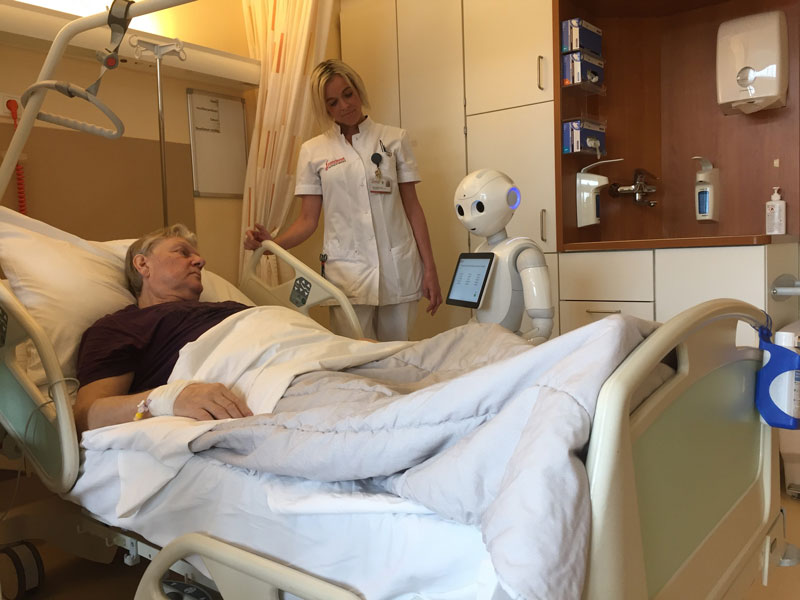by Koen V. Hindriks (Delft University of Technology), Roel Boumans (Delft University of Technology and Radboud university medical center), Fokke van Meulen (Radboud university medical center), Mark Neerincx (Delft University of Technology), Marcel Olde Rikkert (Radboud university medical center)
We are designing a social robot to collect patient data in hospitals by interviewing patients. This task is crucial for improving and providing value-based care. Currently, professional caretakers administer self-reported outcome questionnaires called patient reported outcome measures (PROMs) to collect this data. By delegating this task to a robot, time spent on administration is significantly reduced. Social robots are finding applications in many domains but are particularly interesting for addressing healthcare related problems [1]. We are researching and developing a social robot as an interview robot for administering PROMs [2]. The Radboud university medical center (Radboudumc) Alzheimer Center [L1] and Delft University of Technology Interactive Intelligence Group [L2] have joined forces, combining their expertise on patient measures and providing value-based aged care with complementary expertise on social interaction between robots with patients. The design of the robot is evaluated in the actual care setting where patients are treated at the Radboudumc.

Figure 1: Using the Pepper as interview robot, self-reported patient outcomes can be collected autonomously, reliably, and efficiently at the Vlietland hospital. Source: RTV Rijnmond.
The quality of health care has significantly increased over recent decades as evidenced by the increase in average life expectancy and the high quality of life of elderly people today. Value-based healthcare has been vital in shifting the focus from the medical interventions performed to the value, i.e., the quality of life, that is delivered. Patient reported outcome measures (PROMs) have been crucial for assessing the quality of life of patients, supporting physicians and nurses in delivering personalised healthcare, and institutions in monitoring the effectiveness and efficiency of their services. However, in practice, the administration of PROMs requires considerable effort on the part of healthcare professionals and thus puts a large burden on the healthcare system. Efforts to have patients fill out paper questionnaires or use tablets have not worked well and in practice also require assistance from caretakers. We are evaluating the hypothesis that a social humanoid robot that interacts using voice will be able to autonomously, reliably, and comfortably provide more fitting support to help patients complete PROMs.
Autonomous here means that the robot is capable of administering questionnaires without any intervention or support from a caretaker. Reliable data collection means that the answers the robot collects from patients match those that would have been collected by a caretaker. Comfort, or more broadly acceptance, means that the robot is easy to use and patients feel comfortable while being interviewed by it. A user-centred methodology called situated cognitive engineering has been used to design our interview robot, taking into account both human factors and operational demands. Our approach moreover has been informed by the current social practices in the hospital. Our aim is to provide a context that is as natural as possible and provides a setting that is as realistic as possible for deployment of the robot. In the scenario we designed, a healthcare professional receives patients, introduces, and performs a handover to the robot.
Our focus in the design of the robot has been on integrating various dialogue components for asking PROM questions, asking for confirmation, allowing patients flexibility by skipping questions that do not apply to them, and by integrating a patient-initiated explanation component in case patients need help with a question. The robot welcomes patients by name and explains the interview procedure. The questions asked by the robot are also displayed on the robot’s tablet, and the robot repeats a question if too much time passes before an answer is received. Because reliability is essential, the robot recorded answers are replayed and also displayed on the tablet for confirmation. Explanations are based on advice and experience of professional caretakers. Upon completion, the robot sends the answers to the caretaker by mail. Variation in the dialogue (e.g., for introducing the next question) has been achieved by including minor variations to avoid the dialogue from becoming monotone.
We evaluated the first prototype of our interview robot with participants aged 70+. Patients were interviewed in a hospital examination room twice: once by the robot and once by a nurse. A counterbalanced design to control for order effects was used and the interviews were scheduled with two-week intervals in between. After completion of the robot interviews the nurse returned and performed a post-interview with the patient, to obtain insight into acceptance of the robot. We found that bias of the interview robot compared with the nurse was low using Bland-Altman plots and reliability overall was acceptable. The robot takes longer to administer a PROM but efficiency is acceptable too. Overall, patients indicated that they felt comfortable interacting with the robot but also that there is room for improvement.
Key next steps are to improve the robot’s responsiveness, for example, to additional clarifications that patients share voluntarily. We aim to extend dialogue capabilities to allow for such digressions. Another limitation of the robot is that it is not sensitive to emotional responses of patients who are being questioned about their quality of life. We plan to add emotion detection capabilities to improve the robot’s handling of these situations. It will be very challenging to get this completely right though, thus a key issue will be how we can make the robot aware of its limitations in these situations and provide it with the capability to handover to a caretaker.
Links:
[L1] https://kwz.me/hty
[L2] https://kwz.me/htH
References:
[1] J. Broekens, et al.: “Assistive social robots in elderly care: a review”, Gerontechnology 8:2, 94–103. 2009.
[2] C.B. Forrest: “Digitization of patient reported outcomes”, Value Health, 16:4, 459–460, 2013.
Please contact:
Koen Hindriks
TU Delft, The Netherlands
+31 15 2782523











